Surface or Internal Fatigue Crack Initiation during VHCF of Tempered Martensitic and Bainitic Steels: Microstructure and Frequency/Strain Rate Dependency
Abstract
1. Introduction
- The significance of microstructure inhomogeneity becomes prevailing in VHCF, since the lower the applied stress amplitude, the smaller the number of stress concentration sites that lead to accumulated cyclic plasticity.
- The frequency effect: testing at higher frequencies often leads to an apparent increase in the VHCF strength.
2. Materials Processing and VHCF Testing Approach
3. Results
4. Discussion
5. Conclusions
- At moderate strength level (martensitic 50CrMo4, 37HRC), irreversible surface plasticity prevails and leads to the formation of persistent slip markings (PSM). Depending on the local combination of stress concentration and microstructural barrier strength, the steel may exhibit a true fatigue limit, below which the fatigue life can be considered as infinite.
- At high strength levels (martensitic 50CrMo4, 57HRC, martensitic 16MnCrV 7 7), the stress concentration at internal non-metallic inclusions leads to an accumulation of dislocation plasticity, patterning, grain refinement, and crack initiation in combination with the formation of a fine granular area (FGA). The lower the remote stress amplitude, the larger the FGA, the size of which correlates with the stress intensity threshold ∆Kth for long fatigue cracks.
- In the case of large inhomogeneities, such as the coarse prior austenite grains in the bainitic 16MnCrV 7 7, pronounced stress concentrations at triple points lead to internal crack initiation, even at lower strength levels. Here, FGAs without non-metallic inclusion were observed.
Author Contributions
Funding
Data Availability Statement
Acknowledgments
Conflicts of Interest
References
- Murakami, Y.; Nomoto, T.; Ueda, T. On the mechanism of fatigue failure in the superlong life regime (N > 107 cycles). Part 1: Influence of hydrogen trapped by inclusions. Fatigue Fract. Eng. Mater. Struct. 2000, 23, 893–902. [Google Scholar] [CrossRef]
- Murakami, Y.; Nomoto, T.; Ueda, T. On the mechanism of fatigue failure in the superlong life regime (N > 107 cycles). Part II: Influence of hydrogen trapped by inclusions. Fatigue Fract. Eng. Mater. Struct. 2000, 23, 903–910. [Google Scholar] [CrossRef]
- Murakami, Y.; Yokoyama, N.N.; Nagata, J. Mechanism of fatigue failure in ultralong life regime. Fatigue Fract. Eng. Mater. Struct. 2002, 25, 735–746. [Google Scholar] [CrossRef]
- Mughrabi, H. Specific Features and Mechanisms of Fatigue in the Ultrahigh-Cycle Regime. Int. J. Fatigue 2006, 28, 1501. [Google Scholar] [CrossRef]
- Chai, G.C. The formation of subsurface non-defect fatigue crack origins. Int. J. Fatigue 2006, 28, 1533–1539. [Google Scholar] [CrossRef]
- Chai, G.C. On Fatigue Crack Initiation in the Matrix in Very High Cycle Fatigue Regime. Mater. Sci. Forum 2014, 783–786, 2266–2271. [Google Scholar] [CrossRef]
- Murakami, Y.; Endo, M. Effects of defects, inclusions and inhomogeneities on fatigue strength. Int. J. Fatigue 1994, 16, 163–182. [Google Scholar] [CrossRef]
- Sakai, T. Review and prospects for current studies on very high cycle fatigue of metallic materials for machine structural use. JMMP 2009, 3, 425–439. [Google Scholar] [CrossRef]
- Grad, P.; Reuscher, B.; Brodyanski, A.; Kopnarski, M.; Kerscher, E. Mechanism of fatigue crack initiation and propagation in the very high cycle fatigue regime of high-strength steels. Scr Mater. 2012, 67, 838–841. [Google Scholar] [CrossRef]
- Grabulov, A.; Ziese, U.; Zandbergen, H.W. TEM/SEM investigation of microstructural changes within the white etching area under rolling contact fatigue and 3-D crack reconstruction by focused ion beam. Scr Mater. 2007, 57, 635–638. [Google Scholar] [CrossRef]
- Murakami, Y.; Kanezaki, T.; Sofronis, P. Hydrogen embrittlement of high strength steels: Determination of the threshold stress intensity for small cracks nucleating at nonmetallic inclusions. Eng. Fract. Mech. 2013, 97, 227–243. [Google Scholar] [CrossRef]
- Hong, Y.; Sun, C. The Nature and the Mechanism of Crack Initiation and Early Growth for Very High Cycle Fatigue of Metallic Materials—An Overview. Theor. Appl. Fract. Mech. 2017, 92, 331. [Google Scholar] [CrossRef]
- Hong, Y.; Lei, Z.; Sun, C.; Zhao, A. Propensities of crack interior initiation and early growth for very- high-cycle fatigue of high strength steels. Int. J. Fatigue 2014, 58, 144–151. [Google Scholar] [CrossRef]
- Krupp, U.; Giertler, A.; Koschella, K. Microscopic damage evolution during very-high-cycle fatigue (VHCF) of tempered martensitic steel. Fatigue Fract. Eng. Mater. Struct. 2017, 40, 1731. [Google Scholar] [CrossRef]
- Suresh, S. Fatigue of Materials; Cambridge University Press: Cambridge, MA, USA, 1998. [Google Scholar]
- Dalenda, J.; Thierry, P.-L. A review about the effects of structural and operational factors on the gigacycle fatigue of steels. Fatigue Fract. Eng. Mater. Struct. 2018, 41, 969–990. [Google Scholar]
- Guennec, B.; Ueno, A.; Sakai, T.; Takanashi, M.; Itabashi, Y. Effect of the loading frequency on fatigue properties of JIS S15C low carbon steel and some discussions based on micro-plasticity behavior. Int. J. Fatigue 2014, 66, 29–38. [Google Scholar] [CrossRef]
- Geilen, M.B.; Schönherr, J.A.; Klein, M.; Leininger, D.S.; Giertler, A.; Krupp, U.; Oechsner, M. On the Influence of Control Type and Strain Rate on the Lifetime of 50CrMo4. Metals 2020, 10, 1458. [Google Scholar] [CrossRef]
- Giertler, A. Mechanismen der Rissentstehung und -ausbreitung im Vergütungsstahl 50CrMo4 bei sehr hohen Lastspielzahlen. Ph.D. Thesis, RWTH Aachen University, Aachen, Germany, 2020. [Google Scholar]
- Giertler, A.; Krupp, U. Investigation of Fatigue Damage of Tempered Martensitic Steel during High Cycle Fatigue and Very High Cycle Fatigue Loading Using In Situ Monitoring by Scanning Electron Microscope and High-Resolution Thermography. Steel Res. Int. 2021, 92. [Google Scholar] [CrossRef]
- Man, J.; Petrenec, M.; Obrtlík, K.; Polák, J. AFM and TEM study of cyclic slip localization in fatigued ferritic X10CrAl24 stainless steel. Acta Mater. 2004, 52, 5551–5561. [Google Scholar] [CrossRef]
- Kikukawa, M.; Ohji, K.; Ogura, K. Push-Pull Fatigue Strength of Mild Steel at Very High Frequencies of Stress Up to 100 kc/s. J. Basic Eng. 1965, 87, 857–864. [Google Scholar] [CrossRef]
- Torabian, N.; Favier, V.; Dirrenberger, J.; Adamski, F.; Ziaei-Rad, S.; Ranc, N. Correlation of the high and very high cycle fatigue response of ferrite based steels with strain rate-temperature conditions. Acta Mater. 2017, 134, 40–52. [Google Scholar] [CrossRef]
- Ebara, R. Corrosion fatigue crack initiation in 12% chromium stainless steel. Mater. Sci. Eng. A 2007, 468–470, 109–113. [Google Scholar] [CrossRef]
- Seeger, A. The temperature dependence of the critical shear stress and of work-hardening of metal crystals. Lond. Edinb. Dublin Philos. Mag. J. Sci. 1954, 45, 771–773. [Google Scholar] [CrossRef]
- Bach, J.; Möller, J.J.; Göken, M.; Bitzek, E.; Höppel, H.W. On the transition from plastic deformation to crack initiation in the high- and very high-cycle fatigue regimes in plain carbon steels. Int. J. Fatigue 2016, 93, 281–291. [Google Scholar] [CrossRef]
- Guennec, B.; Ueno, A.; Sakai, T.; Takanashi, M.; Itabashi, Y.; Ota, M. Dislocation-based interpretation on the effect of the loading frequency on the fatigue properties of JIS S15C low carbon steel. Int. J. Fatigue 2015, 70, 328–341. [Google Scholar] [CrossRef]
- Mughrabi, H.; Herz, K.; Stark, X. The effect of strain-rate on the cyclic deformation properties of α-iron single crystals. Acta Metall. 1976, 24, 659–668. [Google Scholar] [CrossRef]
- Stainier, L. A micromechanical model of hardening, rate sensitivity and thermal softening in BCC single crystals. J. Mech. Phys. Solids 2002, 50, 1511–1545. [Google Scholar] [CrossRef]
- Caillard, D. An in situ study of hardening and softening of iron by carbon interstitials. Acta Mater. 2011, 59, 4974–4989. [Google Scholar] [CrossRef]
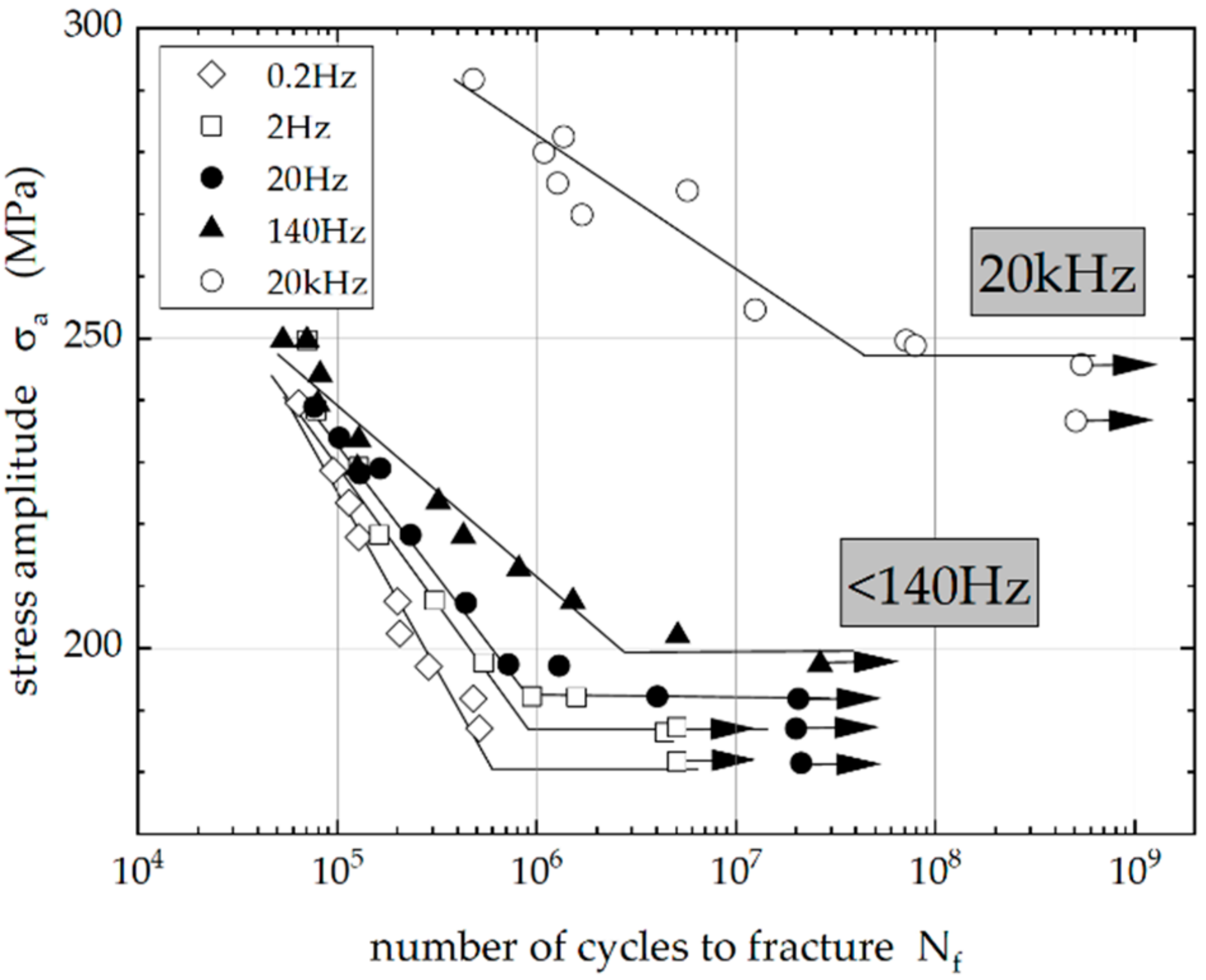
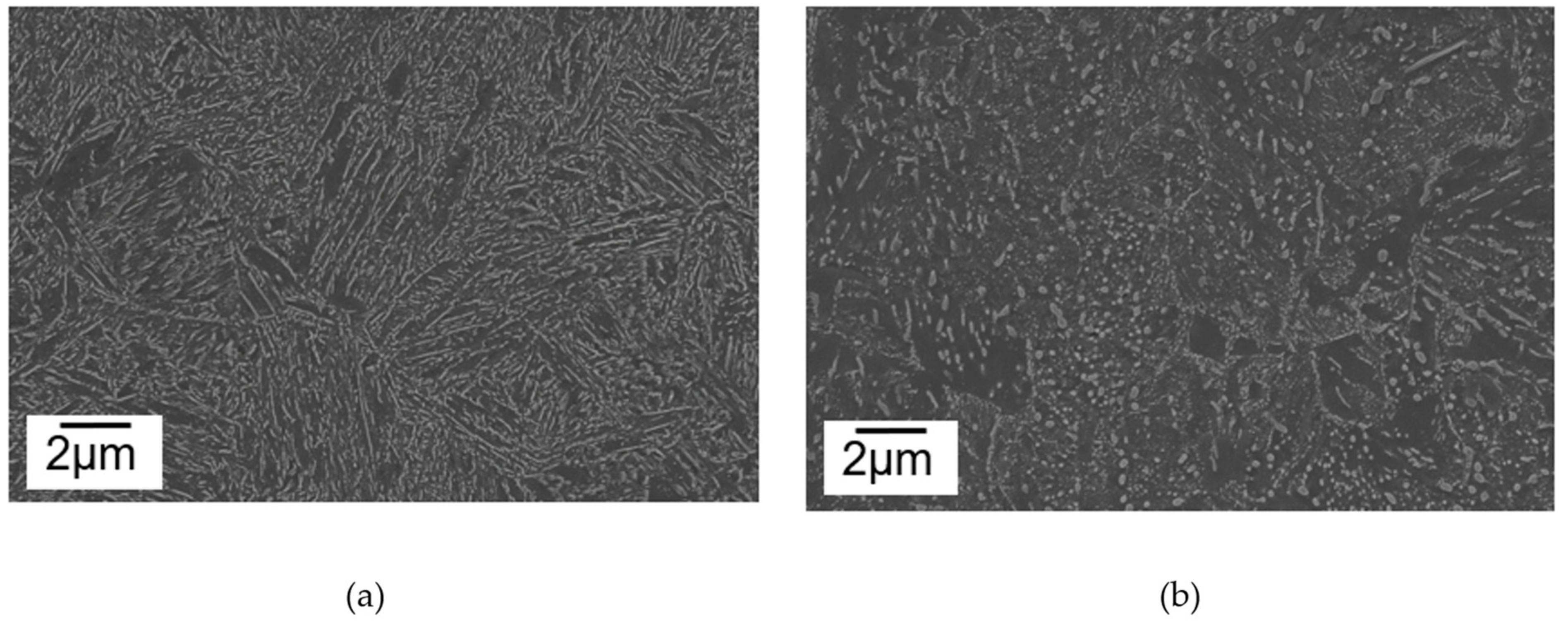


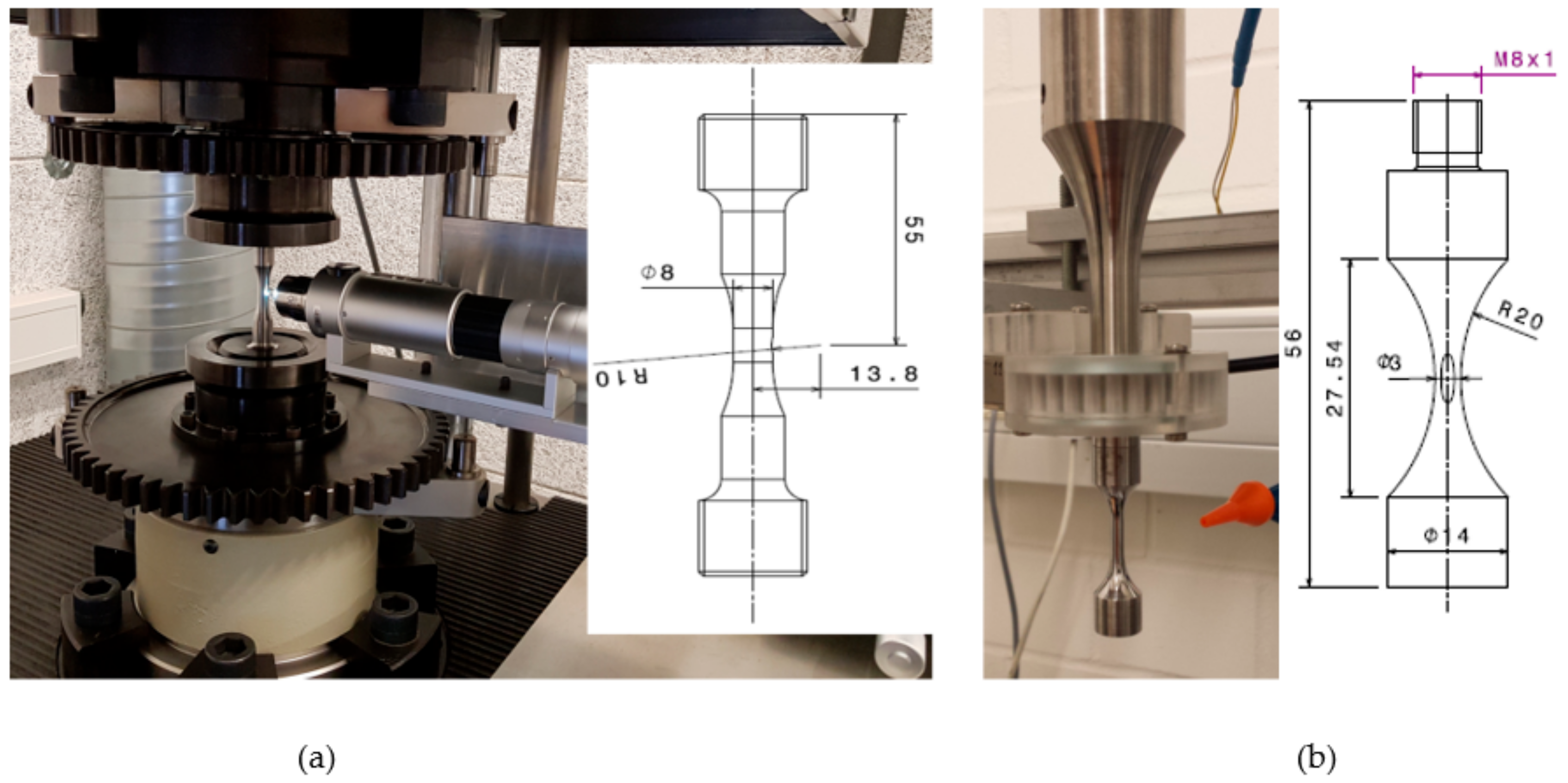
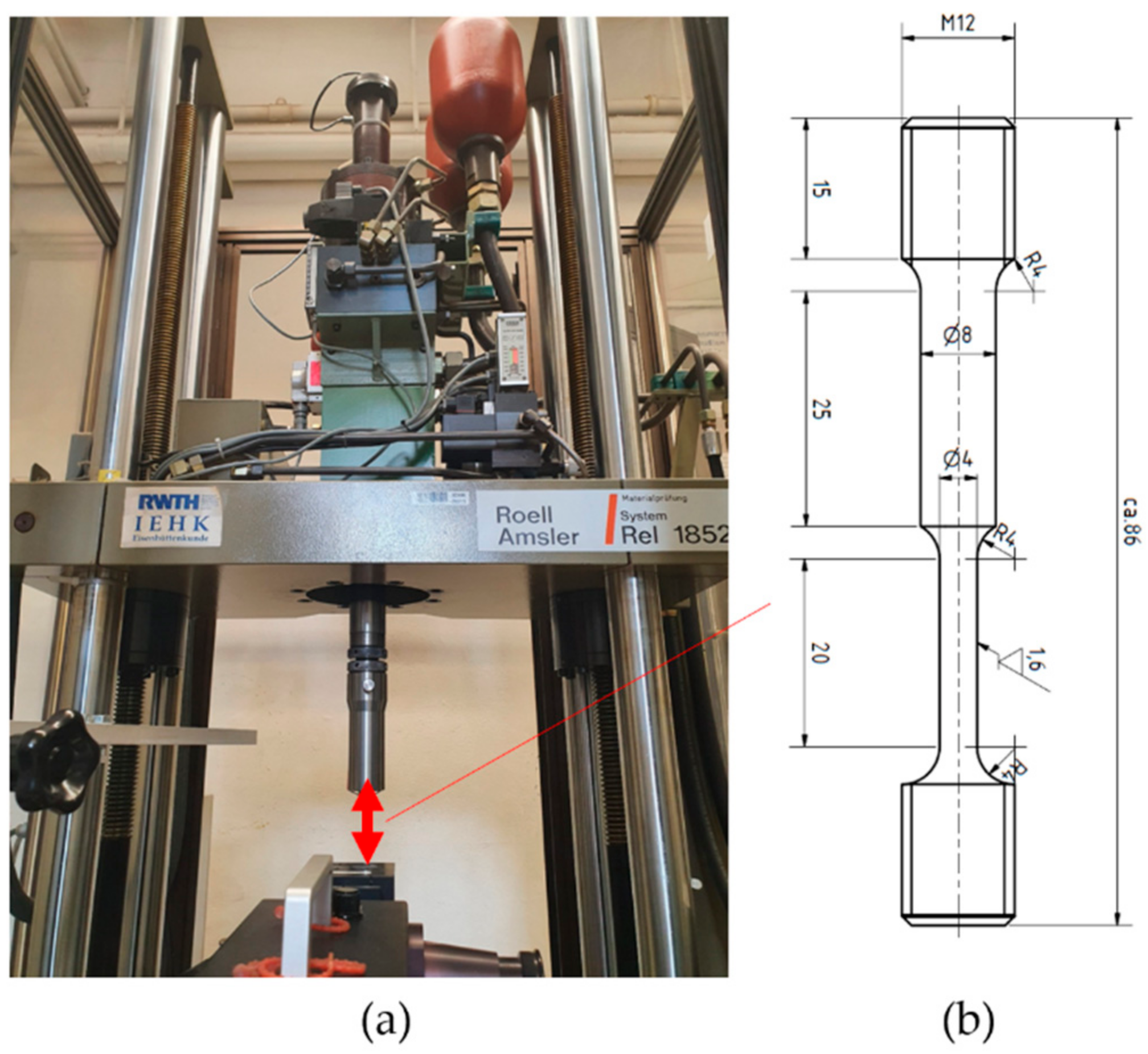

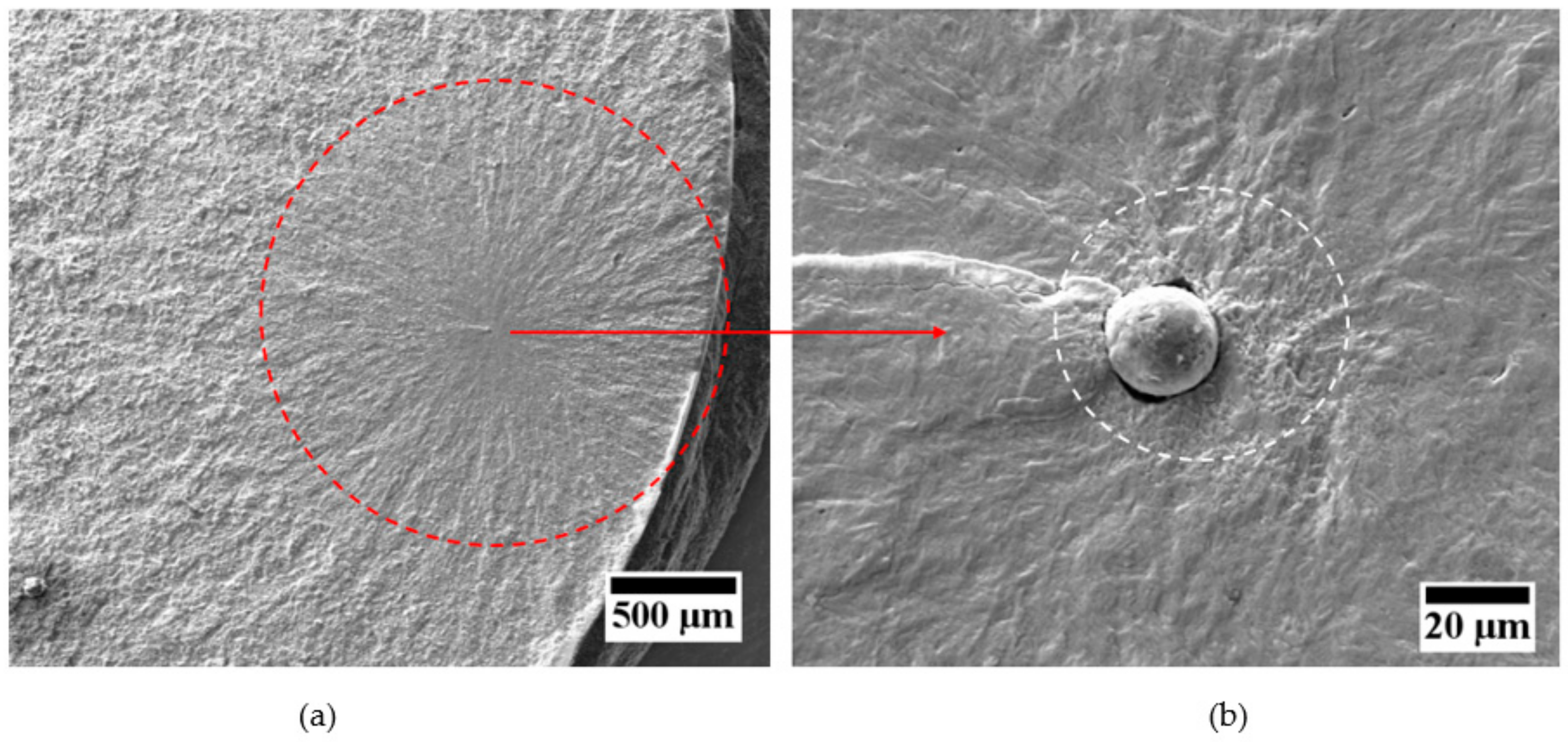

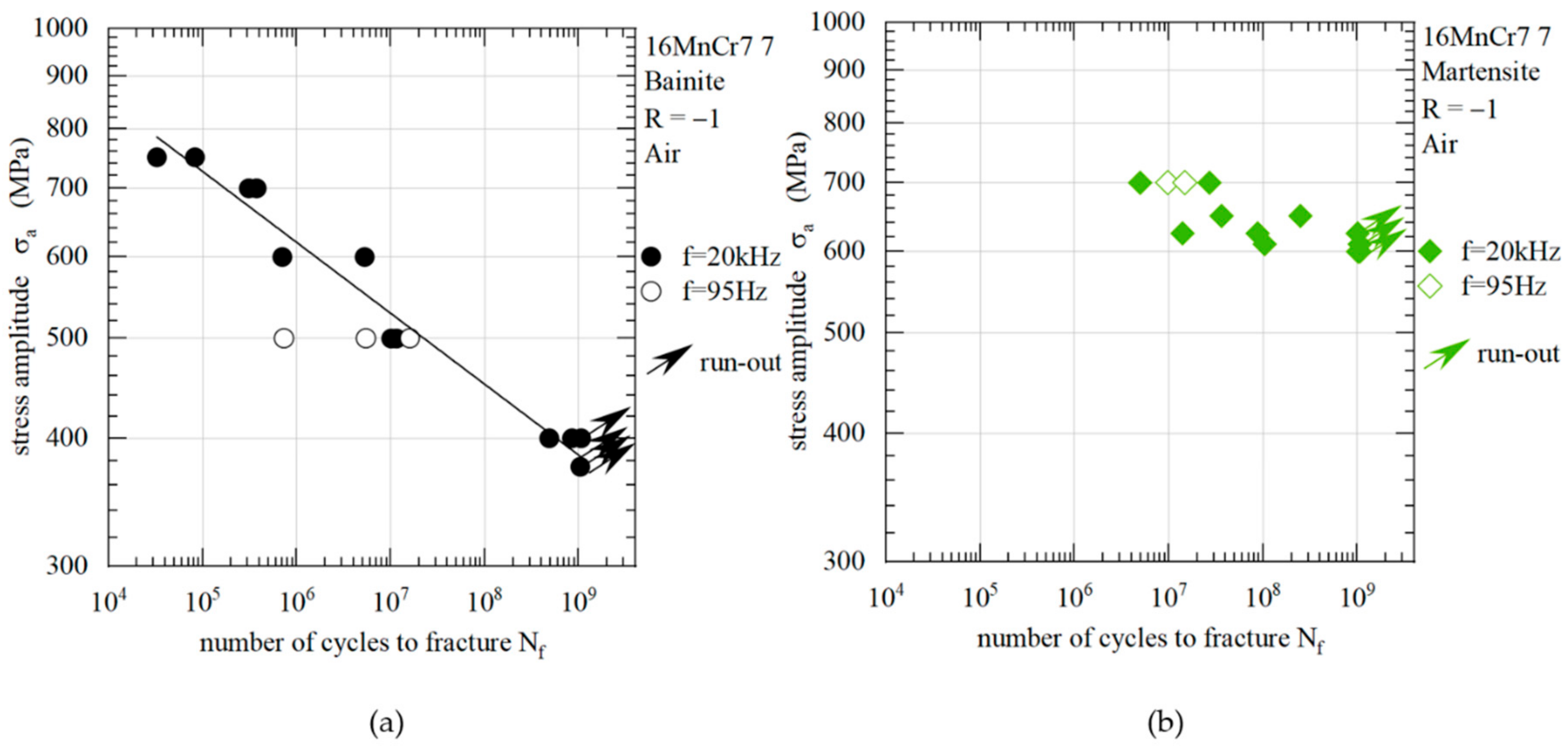

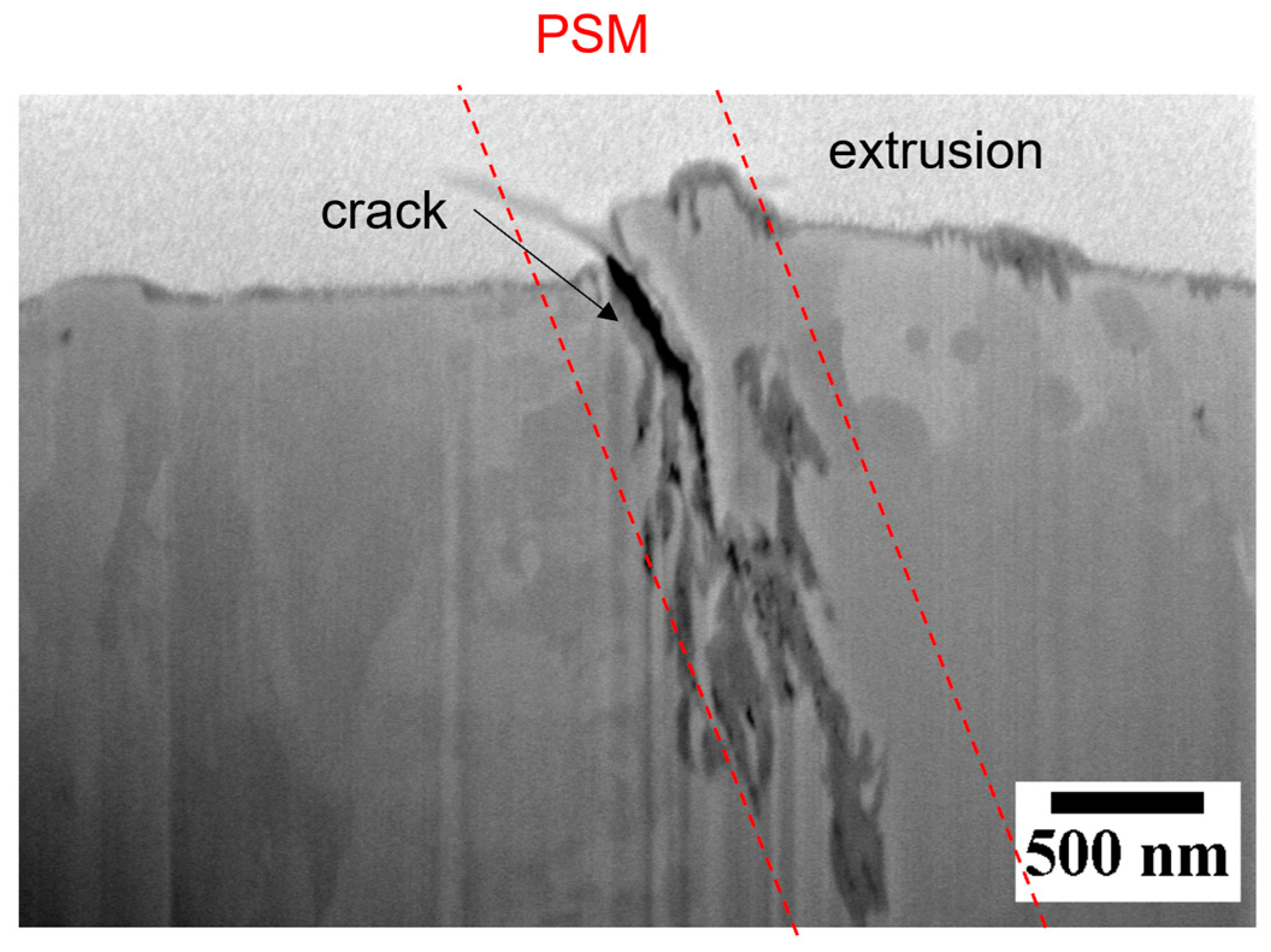

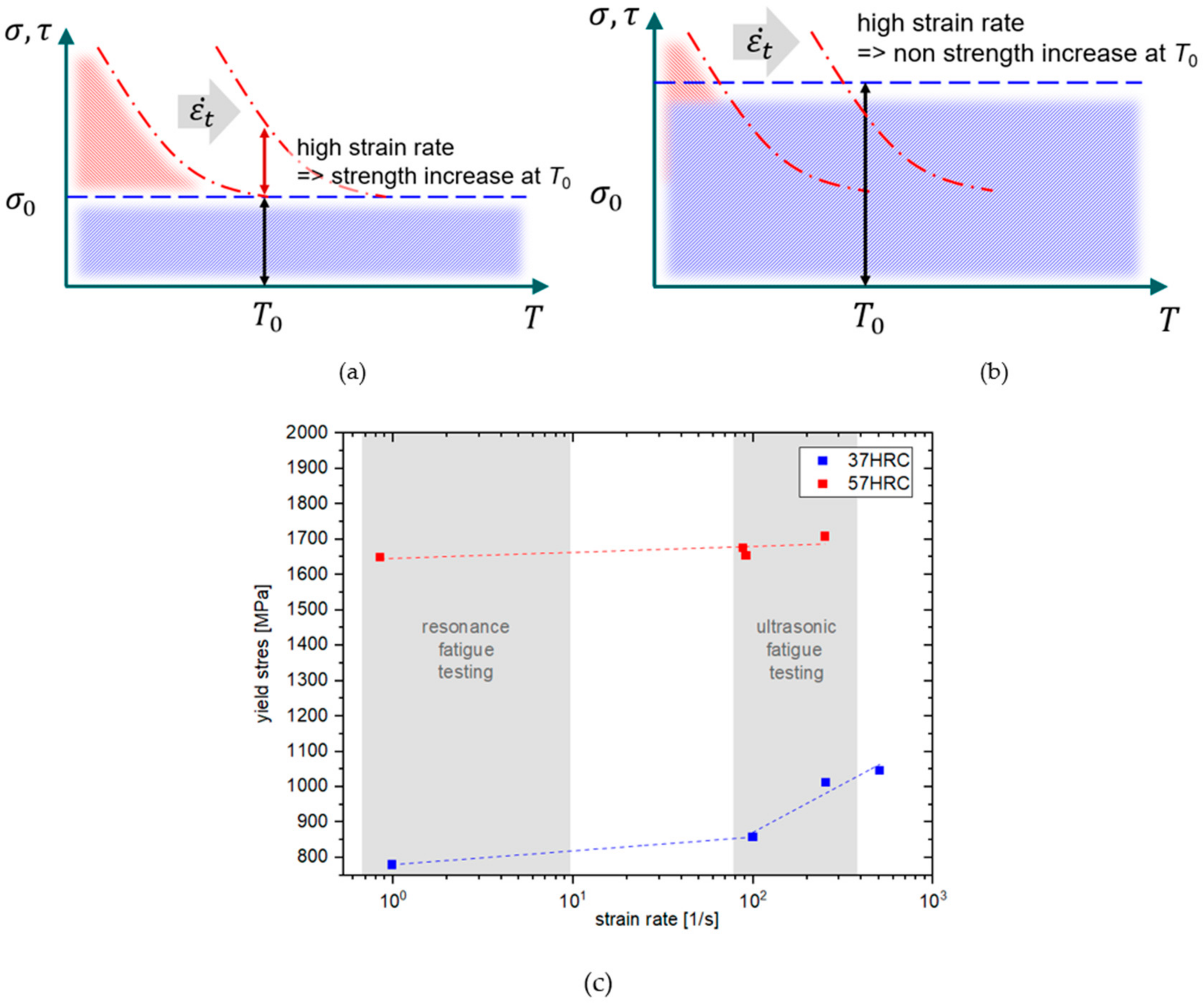
| Material | C | Cr | Mo | Mn | Ni | V + Nb + Ti | Fe |
|---|---|---|---|---|---|---|---|
| 50CrMo4 | 0.48 | 1.00 | 0.18 | 0.71 | - | - | bal. |
| 16MnCrV7 7 | 0.16 | 1.7 | - | 1.7 | 0.16 | 0.17 | bal. |
| Material | Rp0.2 [MPa] | UTS [MPa] | A [%] | Av [J] |
|---|---|---|---|---|
| 50CrMo4—37HRC | 992 | 1095 | - | - |
| 50CrMo4—57HRC | 1561 | 2128 | - | - |
| 16MnCrV7 7 lower Bain.—37HRC | 885 ± 57 | 1197 ± 34 | 57 ± 3.0 | 17 ± 2 |
| 16MnCrV7 7 selftemp.—43HRC | 1000 ± 31 | 1370 ± 34 | 63 ± 0.7 | 104 ± 11 |
Publisher’s Note: MDPI stays neutral with regard to jurisdictional claims in published maps and institutional affiliations. |
© 2022 by the authors. Licensee MDPI, Basel, Switzerland. This article is an open access article distributed under the terms and conditions of the Creative Commons Attribution (CC BY) license (https://creativecommons.org/licenses/by/4.0/).
Share and Cite
Krupp, U.; Giertler, A. Surface or Internal Fatigue Crack Initiation during VHCF of Tempered Martensitic and Bainitic Steels: Microstructure and Frequency/Strain Rate Dependency. Metals 2022, 12, 1815. https://doi.org/10.3390/met12111815
Krupp U, Giertler A. Surface or Internal Fatigue Crack Initiation during VHCF of Tempered Martensitic and Bainitic Steels: Microstructure and Frequency/Strain Rate Dependency. Metals. 2022; 12(11):1815. https://doi.org/10.3390/met12111815
Chicago/Turabian StyleKrupp, Ulrich, and Alexander Giertler. 2022. "Surface or Internal Fatigue Crack Initiation during VHCF of Tempered Martensitic and Bainitic Steels: Microstructure and Frequency/Strain Rate Dependency" Metals 12, no. 11: 1815. https://doi.org/10.3390/met12111815
APA StyleKrupp, U., & Giertler, A. (2022). Surface or Internal Fatigue Crack Initiation during VHCF of Tempered Martensitic and Bainitic Steels: Microstructure and Frequency/Strain Rate Dependency. Metals, 12(11), 1815. https://doi.org/10.3390/met12111815





